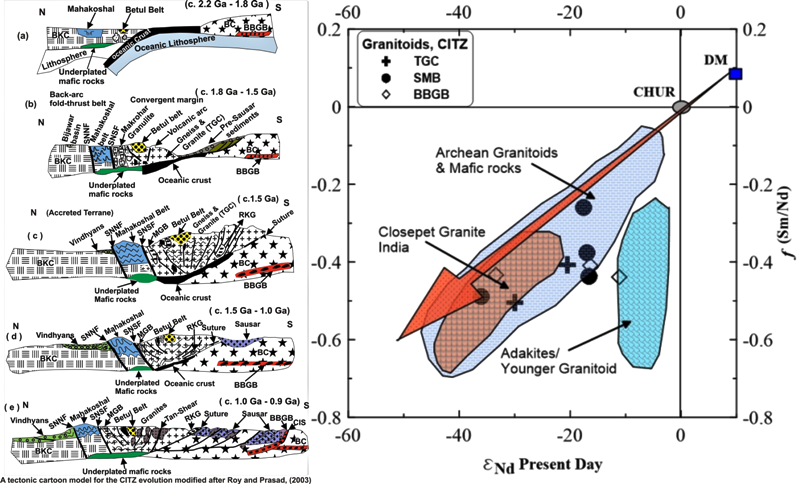
Geochemistry and petrogenesis of Proterozoic granitoids from Central Indian Tectonic Zone (CITZ): elemental and isotopic constraints
ABSTRACT

The Central Indian Tectonic Zone (CITZ) is major E-W trending suture zone between Northern and Southern Indian crustal blocks. The southern portion of the CITZ comprises three litho-tectonic units: Tirodi Gneissic Complex (TGC), Sausar Mobile Belt (SMB) and Bhandara-Balaghat Granulite Belt (BBGB). Elemental and isotopic data are used to constrain the genesis of granitoids and their protoliths, which may help us to understand the Proterozoic crustal evolution in CITZ. Geochemical and isotopic results are consistent with previous studies that these granitoid plutons are linked to the felsic magmatism of the Columbian crustal assembly in India, North America and North China. Granitoids varies from tonalite to granite, alkalic to calcic, metaluminous to peraluminous composition. Normalized elemental ratios of La/Sm, La/Yb, La/Lu, and Gd/Yb depict variable LREE enrichments and varying degrees of partial melting of heterogeneous crustal/lithospheric sources. The studied rocks are characterized by positive anomalies for Pb and negative anomalies for Nb, Sr, P, Ti, which indicate the influence of subduction-zone fluids in the source regions. Negative anomalies for K, Sr, and Ti for SMB and BBGB granitoids may also be attributed to K-feldspar, plagioclase, and Fe-Ti oxide fractionation. However, TGC porphyritic leucogranites display K, Ba and Eu positive anomalies, probably related to the accumulation of K-feldspar phenocrysts. Nd-Sr data presents initial ratios of 143Nd/144Nd t = 1.6 Ga ranges between 0.509961 and 0.510300; εNd t = 1.6 Ga ranges from –5.3 to –11.9 with TDM ages ranging from 2.20 to 2.78 Ga for TGC granitoid. The ratios of 143Nd/144Nd t = 1.6 Ga ranges between 0.510232 and 0.510985; εNd t = 1.6 Ga ranges from +0.2 to +8.2 and TDM ages varies from 1.5 to 3.0 Ga. The initial 87Sr/86Sr t = 1.6 Ga ratios ranges between 0.699834 and 0.797151 for SMB granitoid. However, BBGB granitoids show the ratios of 143Nd/144Nd t = 1.6 Ga ranges between 0.509752 and 0.510910; εNd t = 1.6 Ga ranges from +6.7 to –16, and TDM ages range from 1.51 to 3.29 Ga. The initial 87Sr/86Sr (t = 1.6 Ga) ratios varies between 0.705096 and 0.717440. These ranges of εNd (t) and TDM values possibly indicate their derivation from enriched and heterogeneous crustal/lithospheric sources, and minor components from depleted lithospheric sources.
KEYWORDS
Keywords: granitoids, Nd-Sr isotope, protoliths, lithosphere, Proterozoic crustal evolution, Central Indian Tectonic Zone (CITZ)- Published : 2022
- Released on J-STAGE : 2022/10/26
- Received : 2021/08/31
- Accepted : 2022/09/12
- DOI : https://doi.org/10.2343/geochemj.GJ22016
- J-STAGE URL : https://www.jstage.jst.go.jp/article/geochemj/56/5/56_GJ22016/_article/-char/en
- J-Online ISSN: 1880-5973
- Print ISSN : 0016-7002
- ISSN-L : 0016-7002
All Issues
- Vol.59, 2025
- Vol.58, 2024
- Vol.57, 2023
- Vol.56, 2022
- Vol.55, 2021
- Vol.54, 2020
- Vol.53, 2019
- Vol.52, 2018
- Vol.51, 2017
- Vol.50, 2016
- Vol.49, 2015
- Vol.48, 2014
- Vol.47, 2013
- Vol.46, 2012
- Vol.45, 2011
- Vol.44, 2010
- Vol.43, 2009
- Vol.42, 2008
- Vol.41, 2007
- Vol.40, 2006
- Vol.39, 2005
- Vol.38, 2004
- Vol.37, 2003
- Vol.36, 2002
- Vol.35, 2001
- Vol.34, 2000
- Vol.33, 1999
- Vol.32, 1998
- Vol.31, 1997
- Vol.30, 1996
- Vol.29, 1995
- Vol.28, 1994
- Vol.27, 1993
- Vol.26, 1992
- Vol.25, 1991
- Vol.24, 1990
- Vol.23, 1989
- Vol.22, 1988
- Vol.21, 1987
- Vol.20, 1986
- Vol.19, 1985-1986
- Vol.18, 1984
- Vol.17, 1983
- Vol.16, 1982
- Vol.15, 1981
- Vol.14, 1980
- Vol.13, 1979
- Vol.12, 1978
- Vol.11, 1977
- Vol.10, 1976
- Vol.9, 1975
- Vol.8, 1974
- Vol.7, 1973
- Vol.6, 1972-1973
- Vol.5, 1971
- Vol.4, 1970-1971
- Vol.3, 1969-1970
- Vol.2, 1968
- Vol.1, 1966-1967




